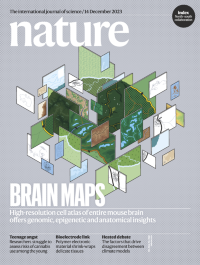Volume 624
-
No. 7992 21 December 2023
One year. Ten stories.With 2023 drawing to a close, we look back on the past 12 months through the lens of Nature’s 10 — ten people who helped to shape science during the year. The cover takes its inspiration from one of the developments that dominated the year: artificial intelligence. The number ten is based on some 1,700 queries from Artificial Worldviews to ChatGPT, which were then visualized as a network connecting people, objects and places with the fields and subfields into which ChatGPT categorizes its knowledge.
-
No. 7991 14 December 2023
Brain mapsIn this week’s issue, researchers working as part of the BRAIN Initiative Cell Census Network (BICCN) present nine papers that map the entire mouse brain in unprecedented detail. Three papers by Hongkui Zeng, Xiaowei Zhuang, Evan Macosko and colleagues describe the transcriptomic and spatial cell atlases of the whole mouse brain, depicting the molecular signatures, spatial organization, and cell–cell interactions of thousands of cell types. (A related paper published earlier by Xiao Wang and co-workers also probes the cell type architecture in the brain.) A pair of papers by Edward Callaway, Joseph Ecker, Zhigang He and colleagues examine the links between the identity of neurons and where they extend their axons. And across three papers, Bing Ren, Joseph Ecker and co-workers examine the epigenetic landscape of the mouse brain, looking at regulatory elements in various cell types. Finally, Karthik Shekhar, Joshua Sanes and colleagues use single-cell RNA sequencing data from 17 vertebrate species to probe the evolution of cell types in the retina.
Nature Outlook
-
No. 7990 7 December 2023
Internal clocksAnimal studies have shown that the ageing process varies not only between individuals but also between organs within an individual. In this week’s issue, Tony Wyss-Coray and his colleagues reveal that this ageing difference holds true for humans, too. The researchers assessed levels of human blood plasma proteins originating from 11 organs to measure organ-specific ageing differences in 5,676 adults. They found that nearly one-fifth of the people showed strongly accelerated ageing in one organ and 1.7% showed ageing in multiple organs. The team suggests that blood proteins offer a ready way to detect the ageing effects in organs, and could help to track health and disease.



